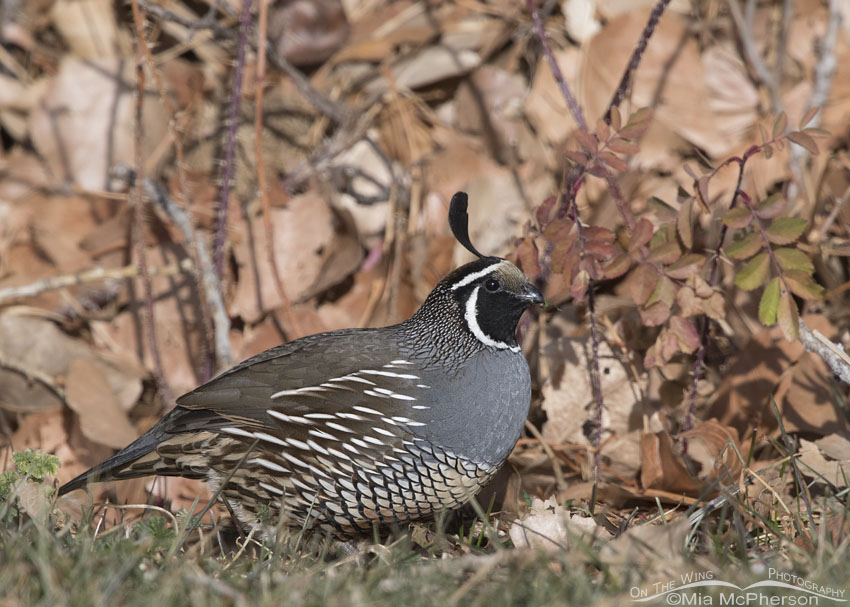 Male California Quail foraging – Nikon D500, f7.1, 1/2500, ISO 500, -0.3 EV, Nikkor 500mm VR with 1.4x TC, natural light
Male California Quail foraging – Nikon D500, f7.1, 1/2500, ISO 500, -0.3 EV, Nikkor 500mm VR with 1.4x TC, natural light
I had a great time photographing a small covey of California Quail that I found yesterday at a city park close to where I live in Salt Lake County. I photographed these upland game birds from the parking lot of the park while inside a vehicle that was being used as a mobile blind. The quail were actively foraging when I first saw and photographed them, they didn’t appear nervous at all but then something flushed them.
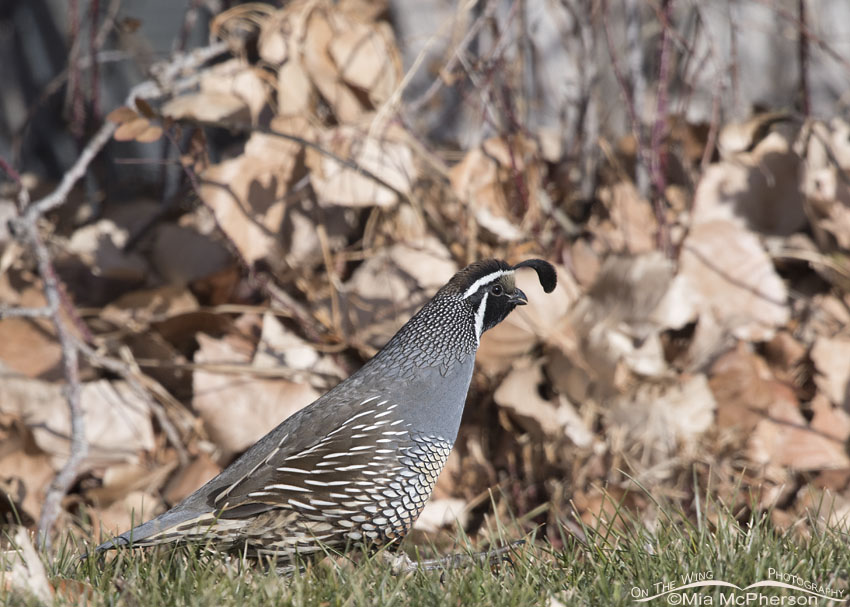 California Quail calling as he walks by – Nikon D500, f7.1, 1/2000, ISO 500, -0.3 EV, Nikkor 500mm VR with 1.4x TC, natural light
California Quail calling as he walks by – Nikon D500, f7.1, 1/2000, ISO 500, -0.3 EV, Nikkor 500mm VR with 1.4x TC, natural light
The quail didn’t go far when they flushed, perhaps only 40 to 50 feet and most of them flew right into a thicket at the edge of a pond. They may have flushed because they saw a predator in the sky that I couldn’t see from inside the vehicle, I know I have seen Cooper’s Hawks in that area on prior visits to the park. After a bit the quail came back out of the thicket and continued foraging but seemed more alert than they had been when I first saw them.
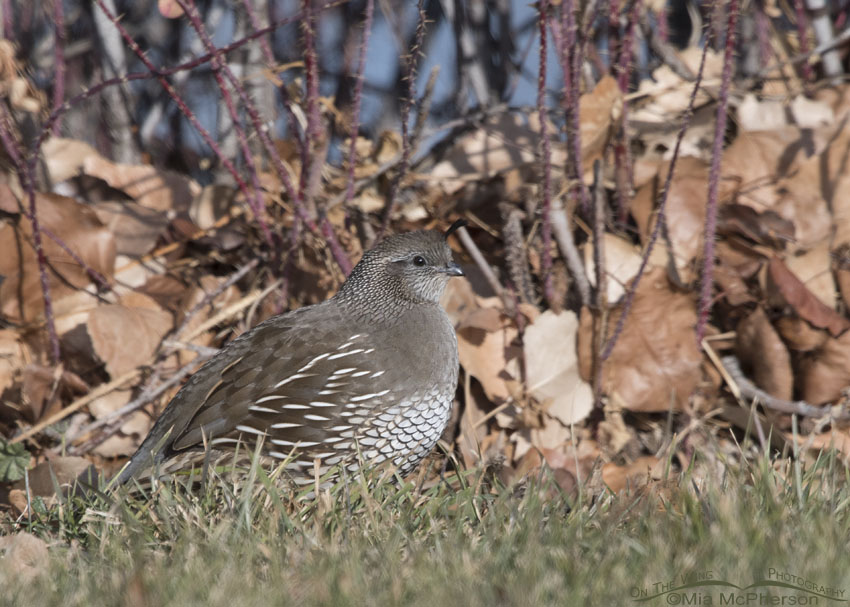 Female California Quail in Salt Lake County – Nikon D500, f7.1, 1/2000, ISO 500, -0.3 EV, Nikkor 500mm VR with 1.4x TC, natural light
Female California Quail in Salt Lake County – Nikon D500, f7.1, 1/2000, ISO 500, -0.3 EV, Nikkor 500mm VR with 1.4x TC, natural light
California Quail are native to the Pacific coast and can be found from Baja, California up to Oregon. This species of quail, according to the Utah Division of Wildlife Resources, were first introduced into Utah at Fort Douglas in Salt Lake City by General John Gibbon in 1869 and two years later California Quail chicks were seen and the species has thrived since then. General John Gibbon who was born in the Eastern U.S. had an interesting military career, loved nature, hunting and fishing and spent the end of his military life in the West. History buffs may want to check out the article I found about him that I linked to above.
So while California Quail are a native North American species they are not native to Utah.
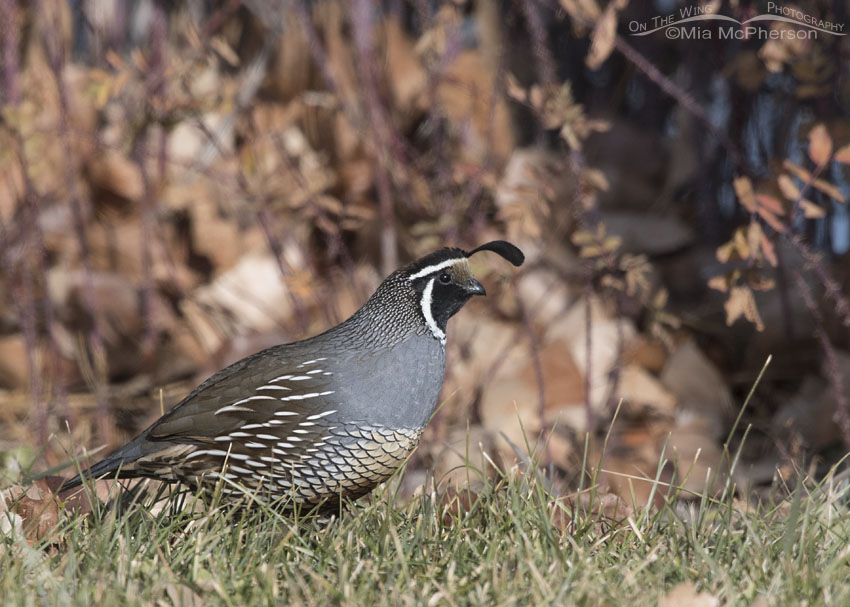 Alert male California male – Nikon D500, f7.1, 1/2000, ISO 500, -0.3 EV, Nikkor 500mm VR with 1.4x TC, natural light
Alert male California male – Nikon D500, f7.1, 1/2000, ISO 500, -0.3 EV, Nikkor 500mm VR with 1.4x TC, natural light
While I was researching how California Quail came to be in Utah I came across a September 2013 article on the Utah Division of Wildlife Resources website about the management of this species in Utah and discovered something I had not previously known about how the state traps California Quail found in parks, golf courses and cemeteries and relocates them.
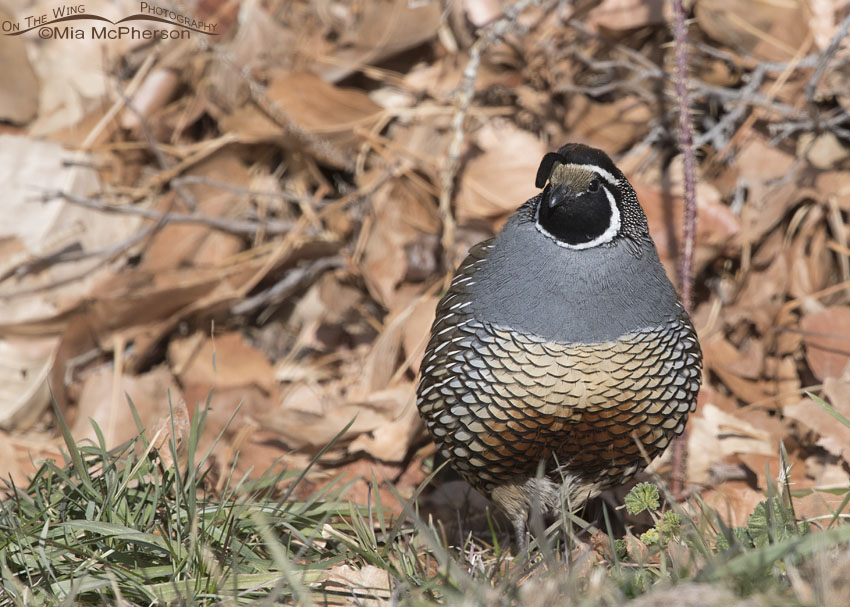 Watchful California Quail male – Nikon D500, f7.1, 1/1600, ISO 500, Nikkor 500mm VR with 1.4x TC, natural light
Watchful California Quail male – Nikon D500, f7.1, 1/1600, ISO 500, Nikkor 500mm VR with 1.4x TC, natural light
From the Utah Division of Wildlife Resources website:
Each winter the Utah Division of Wildlife Resources traps hundreds of California quail for relocation. People are often concerned about the safety of the birds and what we do with them.
Quail management
By taking quail out of urban areas, new populations are established by introducing those birds into new Utah habitats. Trapping occurs in winter when enough snow has fallen to make the quail’s natural food difficult to reach and before they begin to pair off in the spring for mating. Winter coveys are then located in parks, golf courses and even in cemeteries. Wildlife technicians bait traps that can hold about thirty birds with wheat and cracked corn. Traps are checked once or twice each day. These traps are simple “walk in” traps with a large wire funnel on one end. Birds see the bait inside, walk through the funnel, and then cannot figure out how to walk back out. When a covey is captured, each quail’s sex and age is recorded, and each is fitted with an aluminum leg band. The quail are then ready for transplant to their new home, which could be a State Wildlife Management area, public land, or private land.
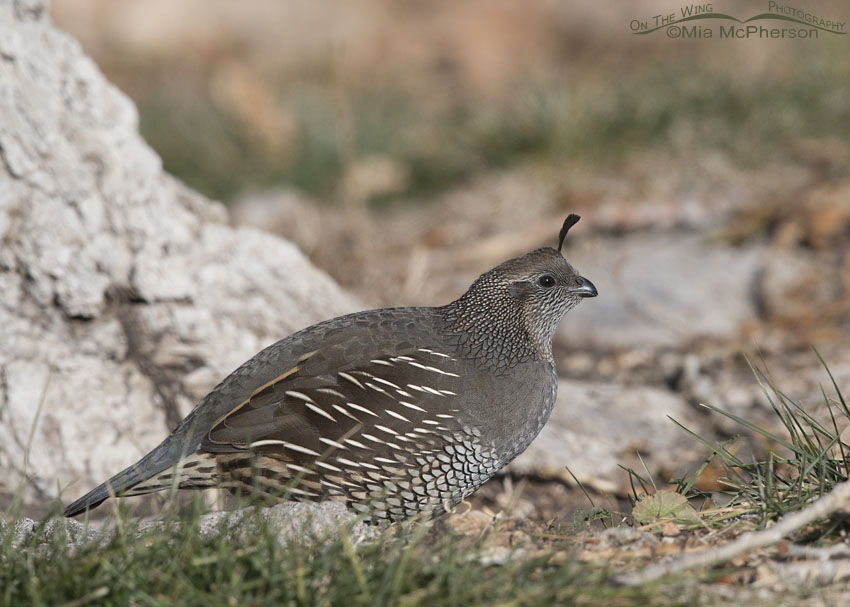 California Quail female foraging – Nikon D500, f7.1, 1/2500, ISO 500, -0.3 EV, Nikkor 500mm VR with 1.4x TC, natural light
California Quail female foraging – Nikon D500, f7.1, 1/2500, ISO 500, -0.3 EV, Nikkor 500mm VR with 1.4x TC, natural light
I don’t know, but it seems odd to me that these quail, found in city parks, private and government owned golf courses, private and publicly owned cemeteries, are trapped and relocated to private lands. I wonder who pays for the relocations to private lands, why they are relocated to private lands and if those private landowners run game farms. I might want to dig a bit deeper into that subject one day.
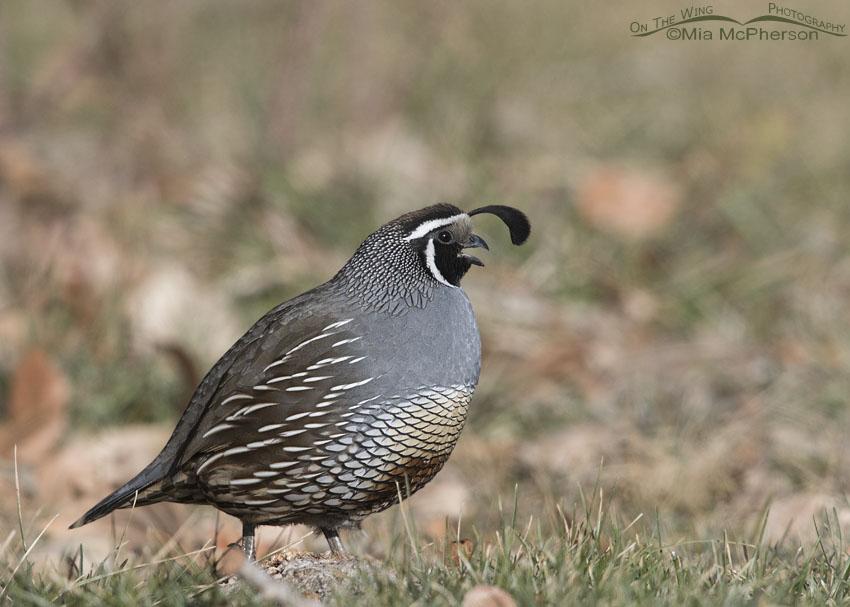 Calling male California Quail – Nikon D500, f7.1, 1/2000, ISO 500, -0.3 EV, Nikkor 500mm VR with 1.4x TC, natural light
Calling male California Quail – Nikon D500, f7.1, 1/2000, ISO 500, -0.3 EV, Nikkor 500mm VR with 1.4x TC, natural light
Back to more pleasant and birdy thoughts…
I hope that I will be able to photograph the California Quail covey at the local park again when there is snow on the ground to hide the manicured grass at the park, I just don’t like lawns in my wild bird photos.
The male California Quail above still seemed bothered by whatever flushed the quail earlier and he showed that with his alarm call which sounded like this.
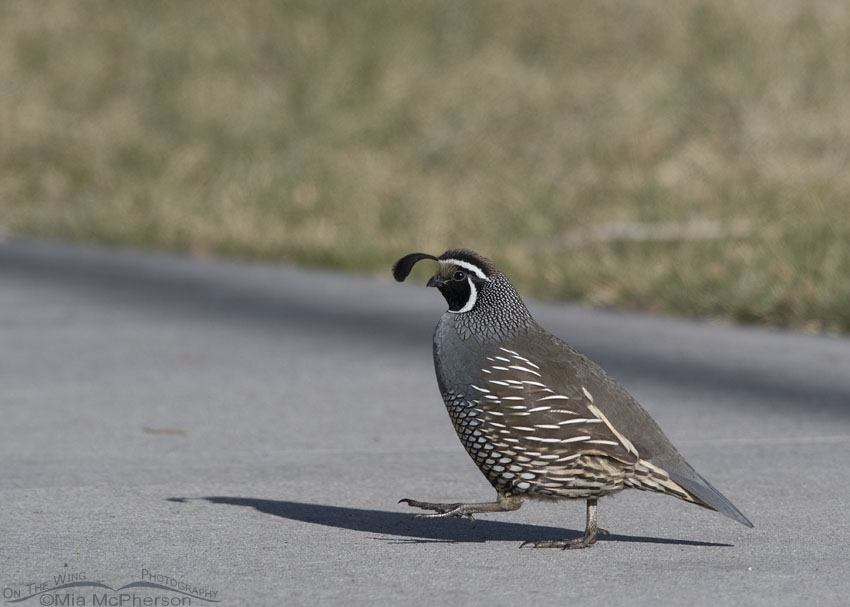 Male California Quail crossing a sidewalk – Nikon D500, f7.1, 1/2000, ISO 400, -0.3 EV, Nikkor 500mm VR with 1.4x TC, natural light
Male California Quail crossing a sidewalk – Nikon D500, f7.1, 1/2000, ISO 400, -0.3 EV, Nikkor 500mm VR with 1.4x TC, natural light
It isn’t uncommon to see California Quail crossing sidewalks, roads and trails in the city and this photo reminded me of how well this species has adapted to living in urban areas. After crossing the sidewalk this quail and the others in the covey wandered out of my sight. I’m glad I have these urban birds to photograph.
Life is good.
Mia
Click here to see more of my California Quail photos plus facts and information about this species.


I second Marlene’s comments above!
Glad to learn a little about the California Quail. They are a beautiful bird. I hope that they are able to pursue the destinations that they desire without any human intervention including the well meaning bird “enthusiasts”.
California quail are also here in Arizona. I suspect the same trapping and relocating activities. I live in rural N. Arizona and it’s not unusual to have to stop and let a covey cross the road.
As for some of the public lands you mentioned (golf courses, city parks, etc.), I would suspect that the use of pesticides/herbicides, mowing and other activities would not be a good environments for these birds. Plus, people have a tendency to complain about the resulting poop, which would land them in the nuisance department. Humans can be so annoying/dangerous. ARGH!
And let me add just plain stupid about the humans.
These funny ittle birds are so cute!!! And i was so excited to soo my first one…..
Thank you all for your comments. Marlene, I am glad my images and posts start your day and I hope usually with a smile.
Tim, CA Quail in Argentina, what a hoot!
Liz, they say they are trying to introduce populations elsewhere in Utah, funny thing is that I only see them outside of urban areas in Utah maybe every two to three years and usually it is a single bird.
April I knew about them relocating Canada Geese because their high numbers can cause issues, I just never realized they did it with California Quail. Your backyard sounds delightful to me!
EC, my suspicious nature worries that those private lands might be game farms, in this state wildlife is not respected to the degree it should be.
Pepe, I could never, ever think of you as pretentious. Not even for a millisecond. You are a delight to me.
I don’t mean to sound pretentious… but looking at these beautiful quail images while listening to the Nutcracker Suite is really cool. Kinda captures the Christmas spirit. At least for me. Great pics Mia. Thanks.
I really, really hope those private lands aren’t game farms. My suspicious nature fears they are.
Yes I knew about the trapping. DNR does the same with Canada Geese. Although I have never seen a California Quail with a leg band.
I have a covey of between 60 and 80 birds in my yard, the ground is a moving mass by my bird feeders at times. I don’t live far from the origainal Fort Douglas, plus we have Red Butte creek behind our house, lots of undergrowth for roosting at night.
What a beautiful bird. Yes, “private land” for relocation makes me think game farm as well. Why remove them from parks in the first place…???
Lovely photos. So much beauty to find within city limits. We found Ca Quail in Patagonia Argentina last Jan. My they get around!
What a fun venture into quails! Thanks. Especially interesting is the history, linking it to Fort Douglas.
You start my day, almost every day, with images that I’m happy to see and sentiments that I usually share. Thanks you!